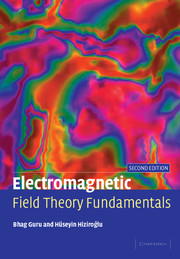Book contents
- Frontmatter
- Contents
- Preface
- Acknowledgments
- 1 Electromagnetic field theory
- 2 Vector analysis
- 3 Electrostatics
- 4 Steady electric currents
- 5 Magnetostatics
- 6 Applications of static fields
- 7 Time-varying electromagnetic fields
- 8 Plane wave propagation
- 9 Transmission lines
- 10 Waveguides and cavity resonators
- 11 Antennas
- 12 Computer-aided analysis of electromagnetic fields
- Appendix A Smith chart and its applications
- Appendix B Computer programs for various problems
- Appendix C Useful mathematical tables
- Index
9 - Transmission lines
Published online by Cambridge University Press: 05 June 2012
- Frontmatter
- Contents
- Preface
- Acknowledgments
- 1 Electromagnetic field theory
- 2 Vector analysis
- 3 Electrostatics
- 4 Steady electric currents
- 5 Magnetostatics
- 6 Applications of static fields
- 7 Time-varying electromagnetic fields
- 8 Plane wave propagation
- 9 Transmission lines
- 10 Waveguides and cavity resonators
- 11 Antennas
- 12 Computer-aided analysis of electromagnetic fields
- Appendix A Smith chart and its applications
- Appendix B Computer programs for various problems
- Appendix C Useful mathematical tables
- Index
Summary
Introduction
In Chapter 8, we discussed the propagation of a plane wave in an unbounded medium. Because the wave had neither electric nor magnetic field components in the longitudinal direction, we referred to it as a transverse electromagnetic wave. We now consider those waves that can exist in regions bounded by conductors. We refer to these waves as guided waves. There are, in fact, three types of guided waves: the transverse electromagnetic wave, the transverse electric wave, and the transverse magnetic wave. Guided waves require conductors for their existence and propagate along the length of the conductors.
When the magnetic field of a guided wave has a component in the direction of its propagation in addition to its other components in the transverse direction, and the electric field is entirely in the transverse direction, the guided wave is called a transverse electric (TE) wave. The guided wave is referred to as a transverse magnetic (TM) wave when the magnetic field is entirely in the transverse direction and the electric field has a component in its direction of propagation. TE and TM waves can exist within a single hollow conductor; we discuss them in Chapter 10, Waveguides and cavity resonators.
The transverse electromagnetic (TEM) wave, also known as the principal wave (or principal mode), requires two or more conductors for its existence. The wave propagates along the length of the conductors with its electric and magnetic fields entirely transverse to its direction of propagation.
- Type
- Chapter
- Information
- Electromagnetic Field Theory Fundamentals , pp. 421 - 501Publisher: Cambridge University PressPrint publication year: 2004
- 1
- Cited by



